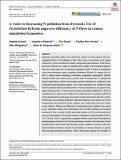Por favor, use este identificador para citar o enlazar a este item:
http://hdl.handle.net/10261/216023COMPARTIR / EXPORTAR:
 SHARE SHARE
 CORE
BASE CORE
BASE
|
|
| Visualizar otros formatos: MARC | Dublin Core | RDF | ORE | MODS | METS | DIDL | DATACITE | |

| Título: | A route to decreasing N pollution from livestock: Use of Festulolium hybrids improves efficiency of N flows in rumen simulation fermenters |
Autor: | Kamau, S.; Belanche, A. CSIC ORCID; Davies, Teri; Rees Stevens, P.; Humphreys, M.; Kingston-Smith, Alison H. | Palabras clave: | Festuca; Festulolium; Lolium; Nitrogen-use efficiency; Protein, Proteolysis; Rumen | Fecha de publicación: | 2020 | Editor: | John Wiley & Sons | Citación: | Food and Energy Security 9: e209 (2020) | Resumen: | Ruminant agriculture suffers from inefficient capture of forage protein and consequential release of N pollutants to land. This is due to proteolysis in the rumen catalyzed by both microbial but initially endogenous plant proteases. Plant breeding-based solutions are sought to minimize these negative environmental impacts. The aim of this study was to perform an integrated study of rumen N metabolism using semi-continuous rumen simulation fermenters (Rusitec) to explore the extent to which swards containing Festulolium populations (interspecific hybrids between Lolium and Festuca grass species) with decreased rates of endogenous protein degradation conferred advantageous protein utilization in comparison with a National Listed perennial ryegrass. An in vitro experiment was conducted using three Festulolium hybrids (Lolium perenne × Festuca arundinacea var. glaucescens, LpFg; Lolium perenne × Festuca mairei, LpFm; and Lolium multiflorum × Festuca arundinacea var. glaucescens, LmFg) and a Lolium perenne, Lp control. LpFm and LmFg demonstrated significantly lower plant-mediated proteolysis than the control. Fresh forage was incubated in Rusitec with rumen fluid from four donor cows. Feed disappearance and production of gas, methane, and volatile fatty acids were similar across cultivars. Whereas no differences in microbial protein synthesis were noted across treatments during early fermentation (0–6 hr after feeding), an increased microbial N flow in LpFm (+30%) and LmFg hybrids (+41%) was observed during late fermentation (6–24 hr after feeding), with higher overall microbial N flows (+13.5% and + 20.2%, respectively) compared with the control (Lp). We propose an underpinning mechanism involving the partitioning of amino acid catabolism toward branched-chain amino acids and microbial protein synthesis in grasses with slow plant-mediated proteolysis instead of accumulation of rumen ammonia in grasses with fast plant-mediated proteolysis. These observations indicate the potential of Festulolium hybrids with a slow plant-mediated proteolysis trait to improve the efficiency of capture of forage protein and decrease the release of N pollutants onto the land. | Versión del editor: | http://dx.doi.org/10.1002/fes3.209 | URI: | http://hdl.handle.net/10261/216023 | DOI: | 10.1002/fes3.209 | Identificadores: | doi: 10.1002/fes3.209 issn: 2048-3694 |
| Aparece en las colecciones: | (EEZ) Artículos |
Ficheros en este ítem:
| Fichero | Descripción | Tamaño | Formato | |
|---|---|---|---|---|
| 2020_Karmau_FES_OA.pdf | 919,77 kB | Adobe PDF |  Visualizar/Abrir |
CORE Recommender
PubMed Central
Citations
4
checked on 24-abr-2024
SCOPUSTM
Citations
7
checked on 14-may-2024
WEB OF SCIENCETM
Citations
6
checked on 26-feb-2024
Page view(s)
107
checked on 21-may-2024
Download(s)
140
checked on 21-may-2024

